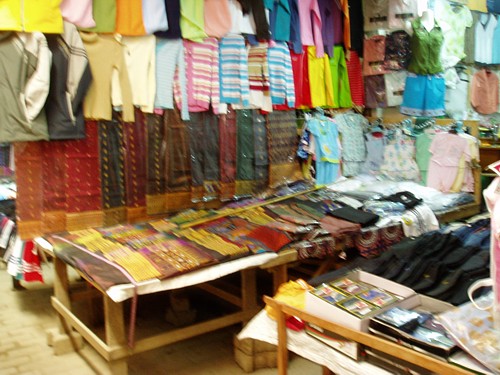
Stalls selling school uniforms, watches, electronics, textbooks, dictionaries & other books are also found in this front section. The right-most part of this front section has a stall or two dealing in ready-made Hmong traditional outfits including various sizes of headgear & materials for DIY embellishment, & somewhere to the left (& outside) of that photo is a row of shops dealing in big fat items like satellite dishes. Interesting how satellite dishes are sold so freely & found sprouting from the humblest of bamboo-&-wood huts in rural villages in a communist country...when in Singapore ordinary citizens are not permitted to own any, & foreign embassies, etc have to fork out the equivalent of 6.5 million kip per year for a permit, per dish.
Behind this front section are the stalls selling dry goods such as toiletries, & behind them are more stalls selling edible dry goods such as packaged food (instant noodles, biscuits & the like), dried fish, spices, kheua/mai sa khan (spicy wood of Piper ribesioides), khai phaen & uncooked rice. Right at the back, both sheltered & in the open, is the 'wet market' section with stuff like vegetables, banana flowers, fish barely swimming in tubs of water & freshly butchered meat.
The cat's loot - lightweight, practical souvenirs that can be folded & flat-packed like IKEA goods:

Lao sinh are usually sold with a matching hem piece (ຕີນ dtiin, lit. foot) tacked on for display:

Stalls usually have plenty of loose hem pieces (bottom left of first photo in this post) for customers who want to mix & match their own choice of cloth & hem pieces. The formal/wedding sinh that come as a whole outfit are trickier, since the accompanying scarf can be of a pattern identical/similar to that of the hem piece. There are also types of sinh material that do not come with separate hempiece, like this, this & this. There will usually be a sewing machine within the stall for on-the-spot tailoring (ຕັດສິ້ນ dtat sin lit. cut skirt), failing which the stall owner will direct customers to a nearby seamstress; both ways, tailoring can be done as quickly as within an afternoon.
This was the cat's first time ever getting clothes tailored. It walked away with three lessons learnt...(1) moneybelts stuffed with baht & kip skew measurements - dumb cat forgot all about its moneybelt & ended up with three sinh that were too loose! (2) specify whether you want the fold in the sinh to be right-over-left or left-over-right - clueless cat ended up with two sinh of the former & one sinh (tailored at a different stall) of the latter (3) specify whether you want a lining, usually made using thin black cloth, to prevent supplementary weft threads on the inside of the sinh from running & becoming worn by friction - ignorant cat ended up with one sinh with lining & two without.
The fold in the sinh means that if the cloth is not long enough for larger girths, it can be extended by sewing on a narrow panel of cloth (usually cheap black material) such that it will be hidden within the fold when the sinh is worn...something noticed while looking at the falang-sized sinh sold in the Luang Prabang night market. For the record, the cheapest sinh (25-28,000kip) are black or blue cotton with white hem pieces aka. the school uniform for Lao girls, but one has to be cat size or smaller to fit into them :P
Most Lao women appear to opt for darker shades for everyday wear (more practical since dirt doesn't show up that easily), & the prettier jewel colours for special occasions. Guess that might explain why the bright colours tend to be of higher quality & more expensive material? The cat hunted high & low for a nice shade of green but all it could find were dull muted dark greens or light olive shades that look too much like the uniforms of Lao women soldiers & policewomen respectively...it would eventually hit paydirt in Huayxai market just before leaving Laos.
Receipts given to the cat were handwritten on small slips of paper torn from old desk diaries or sheets of A4 paper that had already been used on one side. Nice to see recycling in practice but not so nice to realise how those big fat rolls of paper inserted into cash registers, electronic payment terminals & ATMs to churn out mountains of receipts & transaction records - both merchant & customer copies - in more developed countries are so taken for granted. Looking at the squiggles on the receipts, the cat wondered how long it takes one to learn how to distiguish neat & beautiful from messy & illegible handwriting in a totally foreign language...






No comments:
Post a Comment